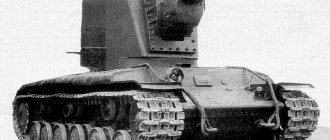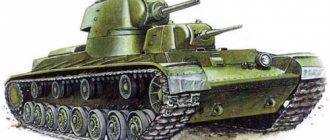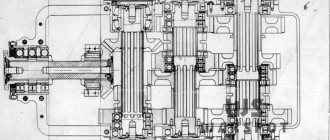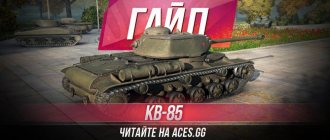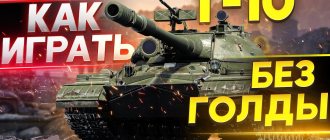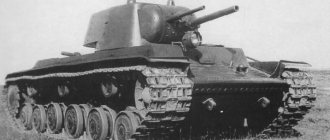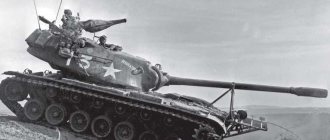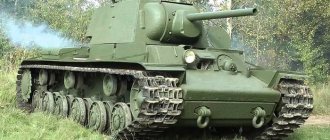Self-propelled artillery systems of the USSR
| Released | Weight t | Crew | Weapons [Ammo] | Speed km/h | Engine | Armor, mm | |||||
| forehead | board | stern | roof | bottom | |||||||
| ZIS-30 , 1941 | 101 | 4,5 | 5 | 57mm ZIS-2 [20] 7.62mm DT [756] | 47 | GAZ M-1 50 hp | 7-10 | 0 | |||
| SU-76 (SU-12), 1943 | 609 | 11,2 | 4 | 76.2mm ZIS-3 [60] | 44 | GAZ-202 2×70 hp | 15-35 | 7 | 7 | ||
| SU-76M (SU-15M), 1943-44 | 11 934 | 10,6 | 45 / 19 | GAZ-203 2×70 hp | 25-30 | 10-15 | 0-15 | 0 | 7 | ||
| SU-122 (SU-35), 1942-43 | 640 | 30,9 | 5 | 121.9mm ML-30 [40] | 55 / 25 | V-2-34 500 hp | 45 | 45 | 45 | 20 | 20 |
| SU-85 (KV-14), 1943-44 | 2 330 | 29,6 | 4 | 85mm D-5 [48] | |||||||
| SU-85M , 1944 | 315 | 31,2 | 85mm D-5 [60] | 50 / 20 | V-2-34M 520 hp | 75 | |||||
| SU-100 , 1944-47 | 2 495 (44-45) | 31,6 | 100mm D-10 [34] | ||||||||
| SU-152 , 1943 | 670 | 45,5 | 5 | 152.4mm ML-20S [20] | 43 / 14 | V-2K 600 hp | 60-75 | 60 | 60 | 30 | 20 |
| ISU-152 , 1944- | 2 674 (44-45) | 46 | 5 | 35 / 18 | V-2-IS 520 hp | 90 | 75-90 | 60 | 30 | 20 | |
| ISU-122 , 1944 | 2 412 (44-45) | 121.9mm A-19 [30] | |||||||||
| ISU-122S , 1944-45 | 121.9mm D-25 [30] 12.7mm DShK [250] | ||||||||||
photo gallery of light self-propelled guns
,
photo gallery of medium self-propelled guns
,
photo gallery of heavy self-propelled guns
Red Army tanks in the Second World War
T-30 Light tank
Developer: GKB under the leadership of Astrov Year of start of work: 1941 Year of release of the first prototype: 1941 Serial production until the autumn of 1941 inclusive. Actively used in the first half of the war with Germany in 1941.
After the launch of mass production of the land modification of the T-40S light tank, the idea arose to refine its design, strengthening the armor and armament due to the saved mass. The new combat vehicle, called the T-30, was practically no different from the serial T-40. The tank's hull remained technologically the same, but the thickness of the frontal part of the hull was increased to 15 mm, and the turret to 20 mm, which made the T-30 equal in level of protection to the T-26 and BT-7 light tanks of the latest production series. Since the navigable equipment was no longer installed in the aft part, a solid armor plate 10 mm thick (without a niche for the propeller) was used.
The chassis of the tank consisted of 4 road wheels with individual torsion bar suspension, 3 support rollers, a front drive wheel and a rear guide wheel.
The engine remained the same - it was a carburetor 4-stroke, 6-cylinder GAZ-202, with a power of 85 hp, installed in the rear of the hull with an offset to the starboard side. The fuel supply in the internal tanks was enough for 300 km.
The tank's armament consisted of a 20-mm TNSh-20 automatic cannon with belt feed and a 7.62-mm DTS machine gun mounted in a coaxial rifle mount. The ammunition load for the cannon was 750 rounds, for the machine gun - 1512 rounds (24 magazines).
The crew of the T-30 and the layout of the fighting compartment have not changed. In the front of the hull there was a place for the driver. Immediately behind him, slightly shifted to the left, was the place of the tank commander, who also served as a gunner and loader. For landing the crew there were two hatches - above the control compartment and in the roof of the tower. For emergency escape of the tank, a hatch was provided in the bottom of the hull. Externally, the T-30 differed from earlier models only in its long cannon barrel and new road wheels.
The production of T-30 tanks took place in parallel with the T-40S and in the reports of plant No. 37 they were listed in a common column, so it is almost impossible to establish the exact number of “thirty” tanks assembled. After the evacuation of the plant near Sverdlovsk, it was possible to assemble another 20 T-30 and T-60 light tanks from the “Moscow” backlog of parts, after which only the T-60 was left in mass production. According to the most accurate estimates, the number of T-30 tanks did not exceed 335 copies.
It is also quite difficult to establish exact data on the combat use of the T-30, since they were often “mixed” with similar T-40 and T-40S. Nevertheless, it is known that from August 1941, light T-30 tanks began to be supplied to the new tank divisions, which were formed mainly near Moscow. For example, the 101st Tank Division (TD) had 15 T-30 and T-40 out of 219 tanks, the 102nd Tank Division had 10 out of 234 units, the 103rd Tank Division had 23 out of 38, and the 105th Tank Division had 23 out of 38 tanks. - 14 out of 169, in the 107th TD - 16 out of 272, in the 108th TD - 38 out of 79, in the 109th TD - 10 out of 229. As a rule, tank divisions were equipped with medium tanks T-34, heavy KV-1 , as well as light BT-5\BT-7 and T-26 of various modifications. During August-October 1941, these units took part in battles on the Central, Bryansk, Reserve and Western fronts, where almost all light tanks were lost.
Around the same time, in September 1941, the 122nd and 9th tank brigades (tbr), which included 64 and 32 light tanks of the T-40 and T types, were sent to the 45th Army near Leningrad. -thirty.
In the autumn of the same year, the 8th Tank Brigade was sent to the North-Western Front, which included 7 KV-1, 22 T-34 and 32 T-30\T-40. Brigades of the same composition (1st, 2nd, 7th, 42nd and 142nd) were distributed between the Bryansk and Southwestern Fronts. In addition, the 142nd Tank Brigade had a “double” staff of light tanks - 64 units.
Subsequently, the number of T-30s and T-40s in tank brigades was greatly reduced. Already in October 1941, the 17th, 19th, 22nd, 24th, 25th, 27th and 28th Tank Brigades were sent to the front as reinforcements, in which the number of light tanks varied from 12 to 32 , and some units were sent T-37A and T-38 tanks to replace failed tanks of new types. Moreover, only the 28th Brigade of the Western Front was equipped with 16 T-30s. Having arrived at the disposal of the 16th Army, the 28th Tank Brigade received the combat mission of defeating the enemy’s Skirman group. To this end, the brigade commander proposed a flank attack, but upon receiving a refusal, he was forced to attack the enemy “head-on.” During October 11-15, together with the 1st Guards Tank Brigade under the command of Katukov, tankers of the 28th Tank Brigade took part in the battles near Kozlovo and Skirmanovo, throwing the enemy from their positions. After this, the brigade was transferred to the subordination of the 1st Cavalry Corps of Major General Dovator, but after a few days the remnants of this unit had to be withdrawn to the rear, since by November 20 there was no material left in it. Combat losses amounted to 4 KV-1, 9 T-34 and 13 T-30. The remaining tanks failed due to technical or non-combat reasons.
Events developed much worse in the zone of operation of the 42nd Tank Brigade. Arriving at the front at the end of September, the brigade was immediately surrounded and forced to retreat to the villages of Novo-Yamskoye, Igritskoye, Semenovskoye. From September 29 to October 3, the tankers did not receive any orders and fought local battles, since control of the troops in this area was virtually lost. It was possible to restore it only by October 7, when the 28th Tank Brigade independently reached the village of Sievsky, where it was repaired by the 148th Rifle Brigade (RD), which was occupying the defense there. By this time, 4 KVs, 8 T-34s and 11 T-30s had been lost.
Subsequently, the tankers supported the actions of the 269th Infantry Division, launching an unsuccessful offensive near the villages of Zelepugovka and Saltykovka. Here the Germans burned 11 Soviet tanks (2 KV, 2 T-34 and 7 T-30), however, after such heavy losses, the brigade continued to be involved in attacks on enemy defensive formations, which ultimately led to its complete defeat. On October 30, the 42nd Tank Brigade lost 6 KV, 18 T-34, 23 T-30, 2 T-40 and almost all artillery in battles.
Perhaps the longest operation of the T-30 in combat conditions continued on the central sector of the Soviet-German front. For example, as of August 21, 1942, the 146th Tank Brigade operating in the Zhizdra River area had 2 KV, 5 T-34, 9 T-60, 1 T-30 and 2 BA-20 armored vehicles. After 10 days of continuous fighting, the brigade lost all KVs, but thanks to reinforcements from the rear and modern repairs, the number of tanks even increased by August 31. The only light tank, the T-30, was apparently lost in the night battle on September 2. Then the 146th Tank Brigade, consisting of 6 T-34s, 10 T-60s and one T-30, together with the 183rd Tank Brigade, took part in the attack on the enemy position near the village of Vorobyovo. Although the Germans offered fierce resistance to the Soviet tankers, they managed to complete their task. However, already in the morning of the next day, German infantry, supported by tanks, began fierce counterattacks and did not stop until the evening of September 3. Soviet reports indicate that during this period the 146th Tank Brigade irretrievably lost only 4 T-34s, another 5 T-34s and two T-60s were shot down. There is no information about the fate of the T-30, but as of September 8, 1942, only 5 T-34s and 1 T-60 remained in the brigade.
Actually, this could be considered the end of the history of the combat use of T-30 light tanks. By the end of 1942, they disappeared from combat units, with the exception of a few vehicles used for security.
To date, only one copy of the T-30 has survived, located in a museum in Moscow.
Sources: M. Svirin “Stalin’s armor shield. History of the Soviet tank 1937-43.” Yauza/EXMO. 2006 M. Baryatinsky “Soviet tanks in battle. From T-26 to IS-2.” YAUZA\EXMO. Moscow. 2007. M. Kolomiets “Front-line Illustration. Amphibious tanks T-37, T-38, T-40." Moscow. Strategy-KM. 2003 I. Moshchansky “Soviet tanks T-30, T-40, T-40S” (monograph). Series "Armored Museum", issue 12. 2007
ACTICO-TECHNICAL DATA OF LIGHT TANK T-30 model 1939
| COMBAT WEIGHT | 5320 kg |
| CREW, people | 2 |
| DIMENSIONS | |
| Length, mm | 4140 |
| Width, mm | 2330 |
| Height, mm | 1950 |
| Ground clearance, mm | 300 |
| WEAPONS | one 20-mm TNSh-20 automatic cannon and one 7.62-mm DTS machine gun |
| AMMUNITION | 50 shells and 1512 rounds |
| AIMING DEVICES | TPMF optical sight and mechanical sight |
| RESERVATION | hull forehead – 9-15 mm hull side – 10 mm turret forehead – 20 mm turret side – 10 mm stern – 20 mm roof – 10 mm bottom – 10 mm |
| ENGINE | hull side – 10 mm |
| TRANSMISSION | mechanical type: clutch (mounted on the engine), gearbox, main and final drives, final clutches with brakes |
| CHASSIS | (on one side) 4 road wheels, 3 support rollers, front drive and rear idler wheels, fine track made of steel tracks |
| SPEED | 45 km/h |
| HIGHWAY RANGE | 300 km |
| OBSTACLES TO OVERCOME | |
| Elevation angle, degrees. | ? |
| Wall height, m | 0,60 |
| Fording depth, m | 1,00 |
| Ditch width, m | 1,70 |
| MEANS OF COMMUNICATION | radio station 71-TK-3 (only on command tanks) |
Armament of USSR armored vehicles
| Caliber mm | Caliber length | Pract. shooting soon | Beginning speed m/s | Corner | Breakthrough guarantee | Projectile weight kg | Armor penetration mm | ||||||||
| 50m | 100m | 500m | |||||||||||||
| DT | 7,62 | 80-125 | 840 | ||||||||||||
| DShK | 12,7 | 80 | 830-850 | 16 | |||||||||||
| TNSH | 20 | 82,4 | 200 | 817 | 60° | 20% | 25 | 18 | |||||||
| Caliber mm | Caliber length | Pract. shooting soon | Beginning speed m/s | Projectile weight kg | Armor penetration mm | ||||||||
| penetration guarantee | 100m | 300m | 500m | 1km | 1.5km | 2km | |||||||
| 20K | 45 | 46 | 7-12 | 757 | 80% | 43(60°) 51(90°) | 36(60°) 43(90°) | 31(60°) 38(90°) | 28(60°) 35(90°) | ||||
| KT | 76,2 | 16,5 | 5 | 370 | 6,5 | 31(90°) | 28(90°) | ||||||
| PS-3 | 76,2 | 20,5 | 11-12 | 530 | |||||||||
| L-10 | 76,2 | 26 | 12 | 558 | 50(90°) | ||||||||
| L-11 | 30,5 | 612 | 55(60°) 66(90°) | 49(60°) 60(90°) | 43(60°) 52(90°) | 38(60°) 46(90°) | 34(60°) 41(90°) | ||||||
| F-32 | 76,2 | 31,5 | 3-8 | ||||||||||
| F-34 | 41,6 | 3-8 | 662 / 950 | 6,5 / 3,02 | 20-80% caliber | 89-74(60°) 94-86(90°) | 82-69(60°) 90-81(90°) | 76-62(60°) 84-75(90°) | 71-55(60°) 78-68(90°) | 55-48(60°) 69-62(90°) | |||
| ZIS-5 | 4-8 | sabot | 95(60°) 120(90°) | 75(60°) 90(90°) | 50(60°) 60(90°) | ||||||||
| ZIS-3 | 6 | ||||||||||||
| Caliber mm | Caliber length | Pract. shooting soon | Beginning speed m/s | Projectile weight kg | Armor penetration mm | ||||||||
| penetration guarantee | 500m | 1km | 1.5km | 2km | |||||||||
| ZIS-2 | 57 | 73 | 15-25 | 990 | 3,15 | 85(60°) 100(90°) | 70(60°) 90(90°) | 65(60°) 70(90°) | 55(60°) 65(90°) | ||||
| ZIS-4 | 6-10 | 995 | 20-80% | 89-83(60°) 105-98(90°) | 85-78(60°) 98-90(90°) | 79-73(60°) 90-82(90°) | |||||||
| D-5 | 85 | 51,6 | 5-8 | 792 | 9,2 / 5 | 80% | 90(60°) 105(90°) | 85(60°) 100(90°) | 78(60°) 92(90°) | 72(60°) 85(90°) | |||
| ZIS-S-53 | 85 | 54,6 | 6-10 | 792 | |||||||||
| D-10 | 100 | 53,5 | 4-6 | 880 | 15,88 | 80% | 125(60°) 155(90°) | 110(60°) 135(90°) | 95(60°) 115(90°) | 87(60°) 110(90°) | |||
| ML-30 | 121,9 | cumulative | 100 | ||||||||||
| A-19 | 121,9 | 43,6 | ?-2,2 | 25 | |||||||||
| D-25 | 121,9 | 43 | 1,2-2,5 | 780 | 80% | 122(60°) 152(90°) | 115(60°) 142(90°) | 107(60°) 133(90°) | 97(60°) 122(90°) | ||||
| M-10T | 152,4 | 436 | 40 | high explosive | |||||||||
| ML-20S | 152,4 | 28,8 | ?-2,3 | 600 | 43,6 | 125 | |||||||
| flamethrower KS-24 | 30-40m | |
| flamethrower KS-25 | 9l each | 45-53m |
| flamethrower ATO-41 | 10l each | 60-65m / 90-100m |
| flamethrower ATO-42 | 70m / 100-130m |
Tank battles in the First and Second World Wars
IDENTIFICATION MARKS OF SOVIET TANKS AND SAU
Transmission
The transmission includes a clutch mechanism and a gearbox. The machines use a clutch with a dry operating principle. The clutch is equipped with 1 disc and is in a permanently closed state. When installing an additional shaft on the tractor to drive implements (PTO), a separate disk is added to the coupling to transmit torque to the shaft.
The manual gearbox and doubler in the rear axle reducer provide 6 normal forward speeds. The reversible gearbox allows you to use these gears for moving backwards. When working in off-road conditions, 2 additional gears are used, allowing you to move in slow motion. Slow speeds only apply to forward movement.
On vehicles of the T-30 family, 2 types of PTO are used - dependent and independent. Both options provide 1 operating speed - 540 rpm. Drive shafts differ in diameter and number of splines; there are 2 configuration options.
Advantages and disadvantages
The characteristics of the T-30 tractor provide a number of advantages:
- ground clearance allowing for work in the field;
- closed cabin with large glass area;
- adjustment of track and ground clearance;
- low fuel consumption;
- ease of repair and maintenance;
- ability to work with various attachments.
Reviews of equipment allow us to highlight a number of disadvantages of the machine:
- low location of the front axle drive shaft;
- the need to adjust the clearance in the clutch;
- low comfort of the operator's cabin.
Price and owner reviews
The cost of used cars starts from 100 thousand rubles. For this price, tractors are offered with standard equipment without attachments. The remaining life of the machines is small; most require major repairs of the engine and transmission. More recent copies cost from 200 thousand rubles. Additional equipment brings the cost to 400 thousand rubles and above.
The cost of the VTZ-2032 tractor in the version with rear drive wheels is 495 thousand rubles, with all-wheel drive - from 60 thousand rubles.
Artem, Tver region.
There are 3 vehicles in operation, modification 30A-80, produced in the mid-2000s. and 1 model - late 90s. On late-release tractors, there are problems with the axle gearbox associated with breakage of shafts and gears. After replacement, the parts do not last long. There are no such problems on an early car. The transfer case and driveshaft are installed low, which causes damage to the unit. There is a high probability of impacts on the crankcase when driving in deep ruts. The engine for all-wheel drive has low power, on the other hand, the chassis cannot cope with more power.
Dmitry, Sochi.
The tractor is used for forestry. Equipped with cabin and glass protection. Protective screens for the front axle drive and oil pump are installed from the factory. The kit included a skidding blade on the front linkage and a forestry plow. The blade was used for lifting purposes; the hydraulic power was enough to move large tree trunks. The vehicle's cross-country ability is at the level of GAZ-66 trucks with all-wheel drive. The cooling system is reliable, it is almost impossible to overheat the engine.
